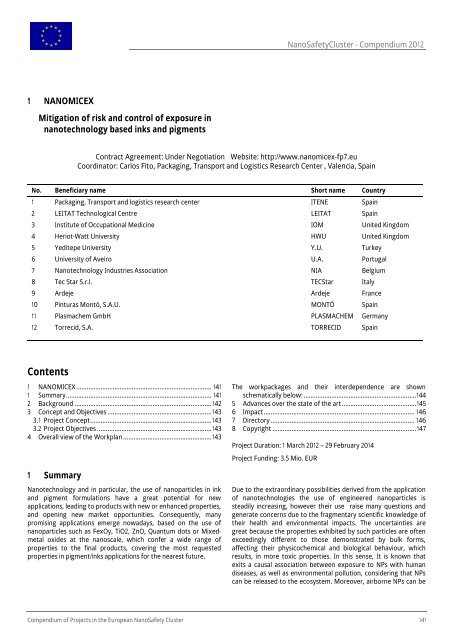Timing, hosts and locations of (grouped) events of NanoImpactNet
Timing, hosts and locations of (grouped) events of NanoImpactNet
Timing, hosts and locations of (grouped) events of NanoImpactNet
You also want an ePaper? Increase the reach of your titles
YUMPU automatically turns print PDFs into web optimized ePapers that Google loves.
1 NANOMICEX<br />
Mitigation <strong>of</strong> risk <strong>and</strong> control <strong>of</strong> exposure in<br />
nanotechnology based inks <strong>and</strong> pigments<br />
NanoSafetyCluster - Compendium 2012<br />
Contract Agreement: Under Negotiation Website: http://www.nanomicex-fp7.eu<br />
Coordinator: Carlos Fito, Packaging, Transport <strong>and</strong> Logistics Research Center , Valencia, Spain<br />
No. Beneficiary name Short name Country<br />
1 Packaging, Transport <strong>and</strong> logistics research center ITENE Spain<br />
2 LEITAT Technological Centre LEITAT Spain<br />
3 Institute <strong>of</strong> Occupational Medicine IOM United Kingdom<br />
4 Heriot-Watt University HWU United Kingdom<br />
5 Yeditepe University Y.U. Turkey<br />
6 University <strong>of</strong> Aveiro U.A. Portugal<br />
7 Nanotechnology Industries Association NIA Belgium<br />
8 Tec Star S.r.l. TECStar Italy<br />
9 Ardeje Ardeje France<br />
10 Pinturas Montó, S.A.U. MONTÓ Spain<br />
11 Plasmachem GmbH PLASMACHEM Germany<br />
12 Torrecid, S.A. TORRECID Spain<br />
Contents<br />
1 NANOMICEX .............................................................................. 141<br />
1 Summary .................................................................................... 141<br />
2 Background ............................................................................... 142<br />
3 Concept <strong>and</strong> Objectives ............................................................ 143<br />
3.1 Project Concept ...................................................................... 143<br />
3.2 Project Objectives .................................................................. 143<br />
4 Overall view <strong>of</strong> the Workplan ................................................... 143<br />
1 Summary<br />
Nanotechnology <strong>and</strong> in particular, the use <strong>of</strong> nanoparticles in ink<br />
<strong>and</strong> pigment formulations have a great potential for new<br />
applications, leading to products with new or enhanced properties,<br />
<strong>and</strong> opening new market opportunities. Consequently, many<br />
promising applications emerge nowadays, based on the use <strong>of</strong><br />
nanoparticles such as FexOy, TiO2, ZnO, Quantum dots or Mixedmetal<br />
oxides at the nanoscale, which confer a wide range <strong>of</strong><br />
properties to the final products, covering the most requested<br />
properties in pigment/inks applications for the nearest future.<br />
The workpackages <strong>and</strong> their interdependence are shown<br />
schematically below: .................................................................144<br />
5 Advances over the state <strong>of</strong> the art ........................................... 145<br />
6 Impact ....................................................................................... 146<br />
7 Directory ................................................................................... 146<br />
8 Copyright ................................................................................... 147<br />
Project Duration: 1 March 2012 – 29 February 2014<br />
Project Funding: 3.5 Mio. EUR<br />
Due to the extraordinary possibilities derived from the application<br />
<strong>of</strong> nanotechnologies the use <strong>of</strong> engineered nanoparticles is<br />
steadily increasing, however their use raise many questions <strong>and</strong><br />
generate concerns due to the fragmentary scientific knowledge <strong>of</strong><br />
their health <strong>and</strong> environmental impacts. The uncertainties are<br />
great because the properties exhibited by such particles are <strong>of</strong>ten<br />
exceedingly different to those demonstrated by bulk forms,<br />
affecting their physicochemical <strong>and</strong> biological behaviour, which<br />
results, in more toxic properties. In this sense, It is known that<br />
exits a causal association between exposure to NPs with human<br />
diseases, as well as environmental pollution, considering that NPs<br />
can be released to the ecosystem. Moreover, airborne NPs can be<br />
Compendium <strong>of</strong> Projects in the European NanoSafety Cluster 141






